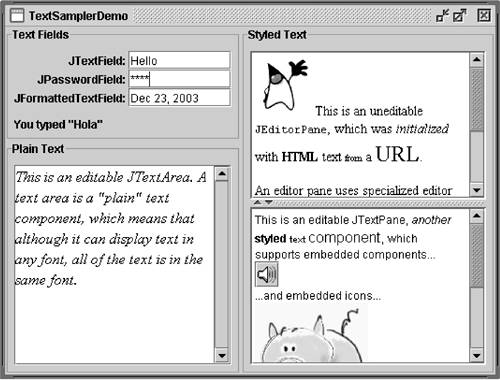How to Use Editor Panes and Text Panes
| < Day Day Up > |
| Two Swing classes support styled text: JEditorPane and its subclass JTextPane . JEditorPane is the foundation for Swing's styled text components and provides the mechanism through which you can add support for custom text formats. If you want unstyled text, consider using a text area instead. See also How to Use Text Areas (page 418). Figure 14 shows TextSamplerDemo , which uses many text components, including an editor pane and text demo. Figure 14. TextSamplerDemo demonstrates the use of each Swing text component in a single application.
TextSamplerDemo hardly begins to exercise the capabilities of editor and text panes. However, the editor pane at its top right does illustrate a very handy, easy-to-use feature: displaying uneditable help information loaded from a URL. The text pane at the lower right demonstrates that you can easily embed images and even components directly into text panes. Note: If you need a full-fledged help system, take a look at the JavaHelp TM system: http://java.sun.com/products/javahelp/. The Swing text API is powerful and immense, and we could devote an entire book just to using editor panes and text panes. This section introduces their capabilities, offers hints on which one you might want to use, and points to other sources of information. Using an Editor Pane to Display Text from a URLOne task that you can accomplish without knowing anything about the Swing text system is displaying text from a URL. Here's the code from TextSamplerDemo.java that creates an uneditable editor pane that displays text formatted with HTML tags: JEditorPane editorPane = new JEditorPane(); editorPane.setEditable(false); java.net.URL helpURL = TextSamplerDemo.class.getResource( "TextSamplerDemoHelp.html"); if (helpURL != null) { try { editorPane.setPage(helpURL); } catch (IOException e) { System.err.println("Attempted to read a bad URL: " + helpURL); } } else { System.err.println("Couldn't find file: TextSampleDemoHelp.html"); } //Put the editor pane in a scroll pane. JScrollPane editorScrollPane = new JScrollPane(editorPane); editorScrollPane.setVerticalScrollBarPolicy( JScrollPane.VERTICAL_SCROLLBAR_ALWAYS); editorScrollPane.setPreferredSize(new Dimension(250, 145)); editorScrollPane.setMinimumSize(new Dimension(10, 10)); The code uses the default constructor to create the editor pane, then calls set- Editable(false) so that the user cannot edit the text. Next, the code creates the URL object and calls the setPage method with it. The setPage method opens the resource pointed to by the URL and figures out the format of the text (which in the example is HTML). If the text format is known, the editor pane initializes itself with the text found at the URL. A standard editor pane can understand plain text, HTML, and RTF. Note that the page might be loaded asynchronously, which keeps the GUI responsive but means that you shouldn't count on the data being completely loaded after the call to setPage returns. Editor Panes versus Text PanesFor most uses of editor panes and text panes, you need to understand the text system, which is described in Text Component Features (page 64) in Chapter 3. Several facts about editor panes and text panes are sprinkled throughout that section. Here we list the facts again, to collect them in one place and to provide a bit more detail. The information here should help you understand the differences between editor panes and text panes and when to use which.
An Example of Using a Text PaneHere's the code from TextSamplerDemo that creates and initializes the text pane. String[] initString = { /* ... fill array with initial text ... */ }; String[] initStyles = { /* ... fill array with names of styles ... */ }; JTextPane textPane = new JTextPane(); StyledDocument doc = textPane.getStyledDocument(); addStylesToDocument(doc); //Load the text pane with styled text. try { for (int i=0; i < initString.length; i++) { doc.insertString(doc.getLength(), initString[i], doc.getStyle(initStyles[i])); } } catch (BadLocationException ble) { System.err.println("Couldn't insert initial text into text pane."); } Briefly, this code hard-codes the initial text into an array and creates and hard-codes several styles ”objects that represent different paragraph and character formats ”into another array. Next, the code loops over the arrays, inserts the text into the text pane, and specifies the style to use for the inserted text. Although this makes for an interesting example and concisely shows off several features of JTextPane , "real-world" programs aren't likely to initialize a text pane this way. Instead, the program would use a text pane to save out a document, which would then be used to initialize the text pane. The Editor Pane and Text Pane APITables 19 and 20 list a bit of the API related to text and editor panes. Many of the most useful methods for JEditorPane and its subclass JTextPane are inherited from JTextComponent . You can find the API tables for JTextComponent in The Text Component API (page 77) in Chapter 3. Also see The JComponent Class (page 53), which describes the API inherited from JComponent . You can also refer to the API documentation for JEditorPane and JTextPane :
Table 19. JEditorPane API for Displaying Text from a URL
Table 20. JTextPane API
Examples That Use Editor Panes and Text PanesTo get started with text, you might want to run these programs and examine their code to find something similar to what you want to do.
|
| < Day Day Up > |
EAN: 2147483647
Pages: 171
